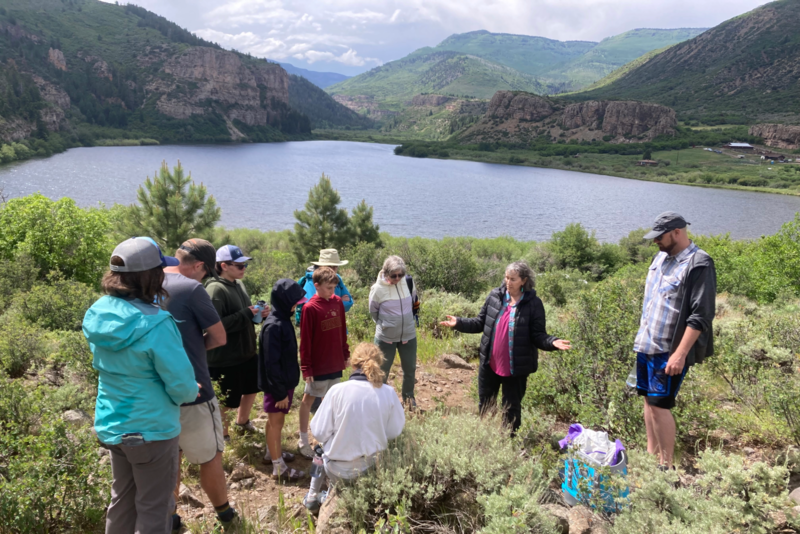News
What Are the Benefits of Forest Bathing?

The smell of the pine trees. The sounds of birds chirping far off in the distance. The feeling of a cool breeze across skin. The sight of water cascading over a rock. Fully tuning into your senses in nature ignites a deeper awareness and an otherworldly sense of belonging, eliciting a feeling of being connected to something bigger than yourself..
When I embarked on a ‘Forest Bathing’ experience hosted by the Eagle Valley Land Trust, I had no idea what to expect. Unlike some common misconceptions about forest bathing, I knew not to bring a swimsuit or towel to this particular bathing excursion. However, as Jane West, an ANFT Certified Forest Therapy Guide and Mental Health Clinician, began guiding our group through, I quickly realized this experience had the potential to wash away all the leftover residue I carried, both emotionally and spiritually.
“The idea is that you’re bathing in the atmosphere of the forest,” said West. “The whole idea of forest bathing without using that term is mindfulness. It’s that present frame.”
Forest bathing is a practice called Shinrin-Yoku that started in Japan in the 1980s as a way to attract people to the idea of deepening their connection to nature and to themselves for the purpose of personal health and in hopes that it benefits the planet and community at every level, said West. After being introduced to the United States about 12 years ago, it is now more commonly referred to as forest therapy in the U.S.
“Look at it as a way of reconnecting with nature,” said West. “There are so many benefits that are being chronicled scientifically, but are things we just know in our bodies already. For many of us that have opted to live in Eagle County, it is the draw to nature.”
As West explains, when our lives become busier, we might drift away from the inspiration nature provides. Forest bathing invites us to slow down and immerse ourselves in the natural environment.
“Forest bathing allows us to remember what brought us here, and it really brings that home. Because it comes into our bodies as an experience,” she said. “The original idea was to get people out there and connected.”
For me, the experience of forest bathing felt like a walking meditation, with West guiding each focused moment with prompts that drew attention to the breath, the surroundings, and being fully present and immersed in each sensation, both physically and emotionally.
“Sometimes when people go out, they feel this completeness to be out in nature that comes from way way back,” said West. “Sometimes people feel a lot of joy doing it. Sometimes people are connected to a sadness that mixes in. You can kind of go in and out of that. It brings up a lot of things that are very manageable in a 2-3 hour walk.”
Benefits
According to West, there is a distinction between forest bathing and simply being outside. The ideal dose of nature is 2 hours, 20 minutes a week, broken down in any increment. Researchers have found that increased exposure to a forest environment can lead to more significant reductions in blood pressure and certain stress hormones.There are physical benefits to forest bathing, with research supporting its positive effects on the immune system, the cardiovascular system, and the sympathetic nervous system. A Japanese study found inhaling phytoncides, compounds derived from trees such as pine trees, reduced stress hormones in both men and women while also enhancing the activity of white-blood cells, which are key in fighting off cancer.
There are also impacts on mood, mental health, and quieting our bodies. West emphasized that connecting to a person’s sense of ‘awe’ can enhance a feeling of connection to things that are bigger than ourselves.
“Going out in nature can lift our mood and reduce our anxiety, especially if we are in places we feel relatively comfortable,” said West. “Forest bathing does challenge a bit our edge zone, our comfort zone, because we’re doing things like closing our eyes in nature or allowing our imaginations to go, so there’s still always a mild discomfort of what are we doing, what are we doing next. It’s all about deepening our connection.”
Connection can also be found with others, and forest bathing was originally designed to be in groups because we benefit from being together and broadening our experience through the insights of others, sharing what we see, feel, hear, taste and smell.
“We also benefit so much from being together. That present moment is magnified by others,” said West. “People go on walks a lot, but do we actually stop talking?”
West recommends slowing down, stopping, and being in silence together.
“There’s no assumption that people aren’t already out in nature a lot here. That’s what brought many of us here. But how often are we just sitting next to something that’s drawing our attention and giving ourselves permission to just be there, noticing more. That’s probably the main thing we give permission for in forest bathing,” she said.
Forest bathing is not limited to warm, summery weather.
“It is glorious to forest bathe in the winter,” said West. “Some of the most wonderful walks I’ve had have been along our creeks - very carefully, not getting in the creek - but noticing the ice, the snow. Going out in a falling snow is amazing. You are noticing, very present-minded, those snowflakes coming down on your gloves. You can move around just enough that you stay warm enough to do forest bathing in the winter.”
So how often do you need to forest bathe to reap the benefits?
“You could do this once and it just sticks with you,” said West. “When you’re out otherwise, after the walk, it just kind of sticks with you. It’s something you added to your toolkit of life.
Tips for Forest Bathing On Your Own
According to West, everyone can incorporate nature connection practices on their own at home with these tips. “Nature is everything. Anywhere you are,” said West. “It’s allowing yourself that time to slow down, go into your senses, appreciate what is around you, and allow it to speak to you in whatever way. That can happen almost anywhere.”
Sit Spot
Choose a place you can visit frequently without too much effort. The ideal sit spot is in a wild and natural area, particularly near an ecotone (a place where two ecological systems meet, such as the edge of a meadow where it meets a forest). Your aim is to visit frequently, daily if possible, and to sit quietly so that the birds and animals nearby get past the initial alarm they feel when a human shows up. Choose a place that is practical for you, even if it is less than ideal. Your front porch or stoop could make a great sit spot.
Thirty minutes is a good length of time for sitting. Over a period of weeks, the local animals will get to know you as an individual and will become more accepting of your presence. They will act more naturally, and you will have increasingly frequent observations of their natural behaviors and interactions with them.
If you wait long enough, a story will unfold. Within a half hour, there is always some kind of story… birds caw at each other, a coyote trots by, rabbits chase each other in circles, a hawk swoops in and hunts a snake.
Visit your sit spot throughout the seasons, in all kinds of weather, and at different times of day and night. The periods leading up to sunrise and right after, and sunset and the hour after, are particularly rich with opportunities to observe.
Place Tending
Choose a place that needs tending, and visit it frequently. Part of what this means is just walking around and giving it the gift of loving human company. You can also pick up trash, talk to visitors, and keep track of what birds are nesting and where. Your place may be as simple as a small garden plot in your yard or a planter box on your apartment’s balcony.
Wandering
This is a version of Shinrin-Yoku that is quite simple. Go to a park or natural area where there are trails you can follow easily and simply wander. Be relaxed, move slowly, be attentive. Do this repeatedly throughout the natural cycle of seasons.
Gratitude Altars
At your sit spot, the places you tend, and in special places that you discover while wandering, build small structures to express your gratitude. Make them out of sticks and stones, feathers and flowers and ferns, and any other beautiful but impermanent objects you find. Make it a practice to maintain these structures, always thinking or speaking what you are grateful for, as you rebuild and reshape them each visit.
If you are looking for a fully-immersed forest bathing experience, the Eagle Valley Land Trust frequently hosts free events locally in the Eagle River Valley.
More News
-
New!
More

Screening Secrets: What Every Man Should Know About Prostate Cancer Screening
Prostate cancer is the most common type of non-skin related cancer in men, and it is the second leading cause of cancer-related deaths in men within the United States, behind lung cancer. Fortunately, if caught early, prostate cancer remains highly treatable and curable with minimally invasive procedures.
-
New!
More

Unplug to Recharge: Why a Digital Detox Is the Real Power Move for 2026
Our phones promise connection, convenience and control, yet most of us feel more scattered, stressed and sleepless than ever. The constant pings, scrolls and notifications have rewired our brains for distraction. The fix? Not abandoning technology altogether, but reclaiming balance.
-
New!
More

Beyond the Scale: Why Nutrition and Exercise Work Better Together
For decades, weight loss advice has been distilled into a simple equation: calories in, calories out. Eat less, maybe combine that with exercise, and the pounds will fall away. But according to experts at Vail Health, that equation overlooks a much bigger picture.





